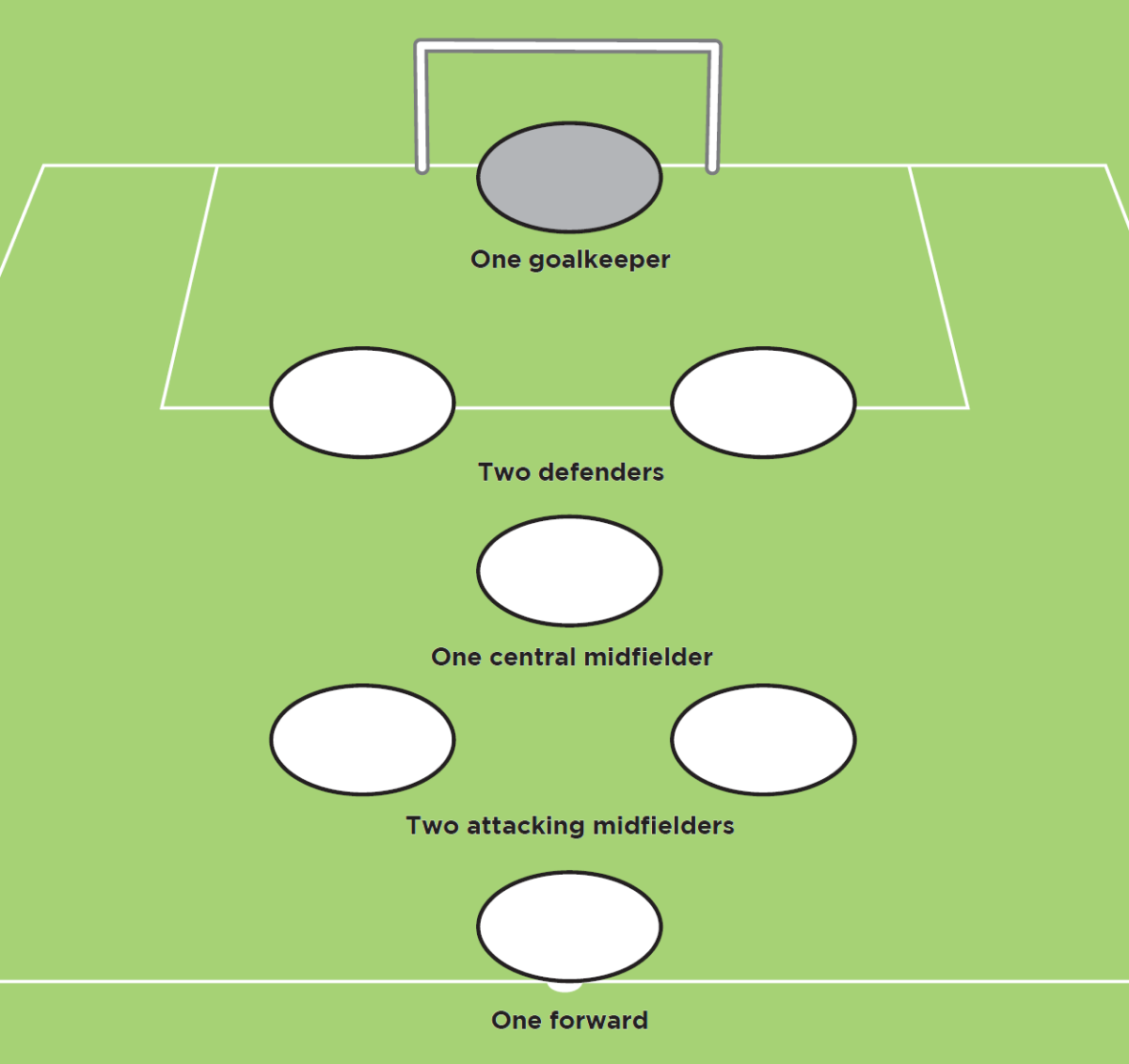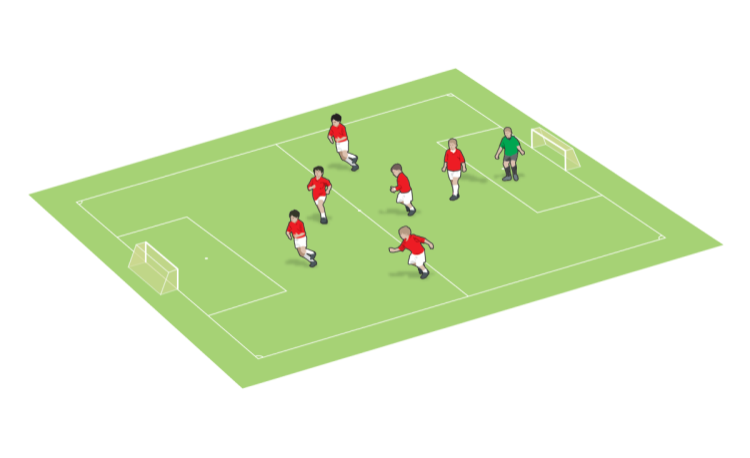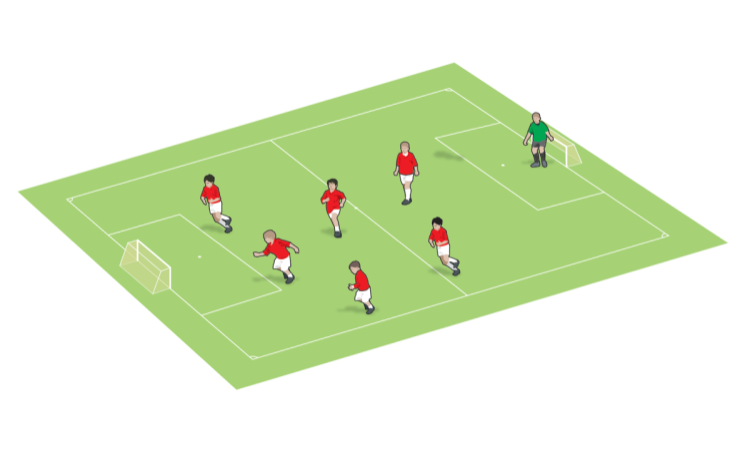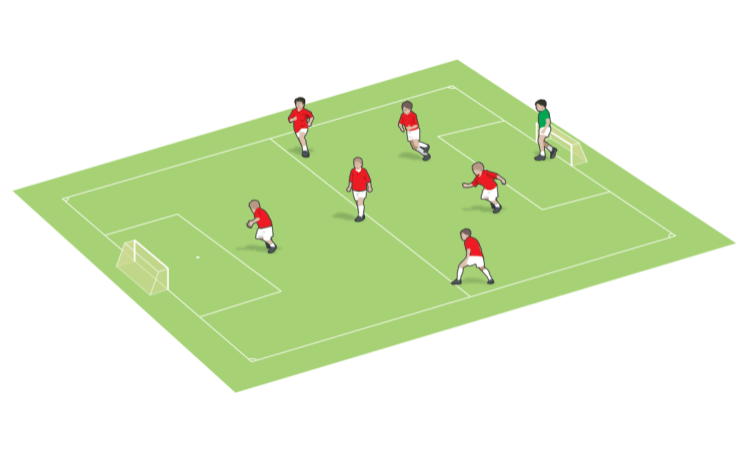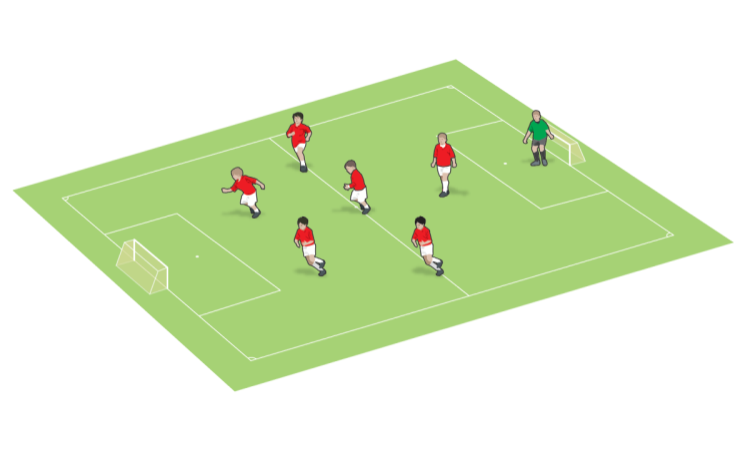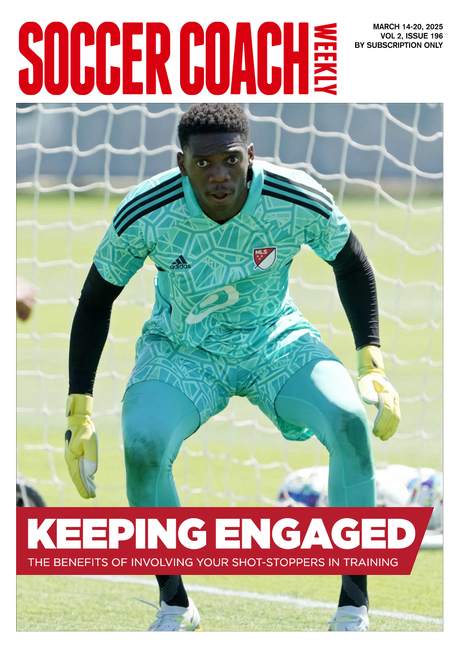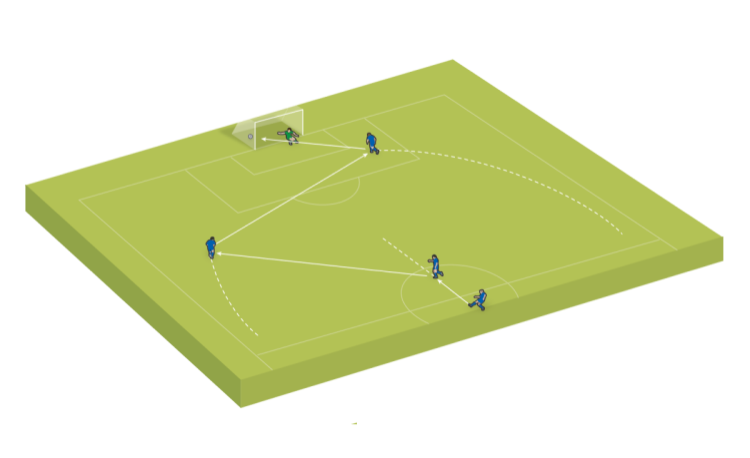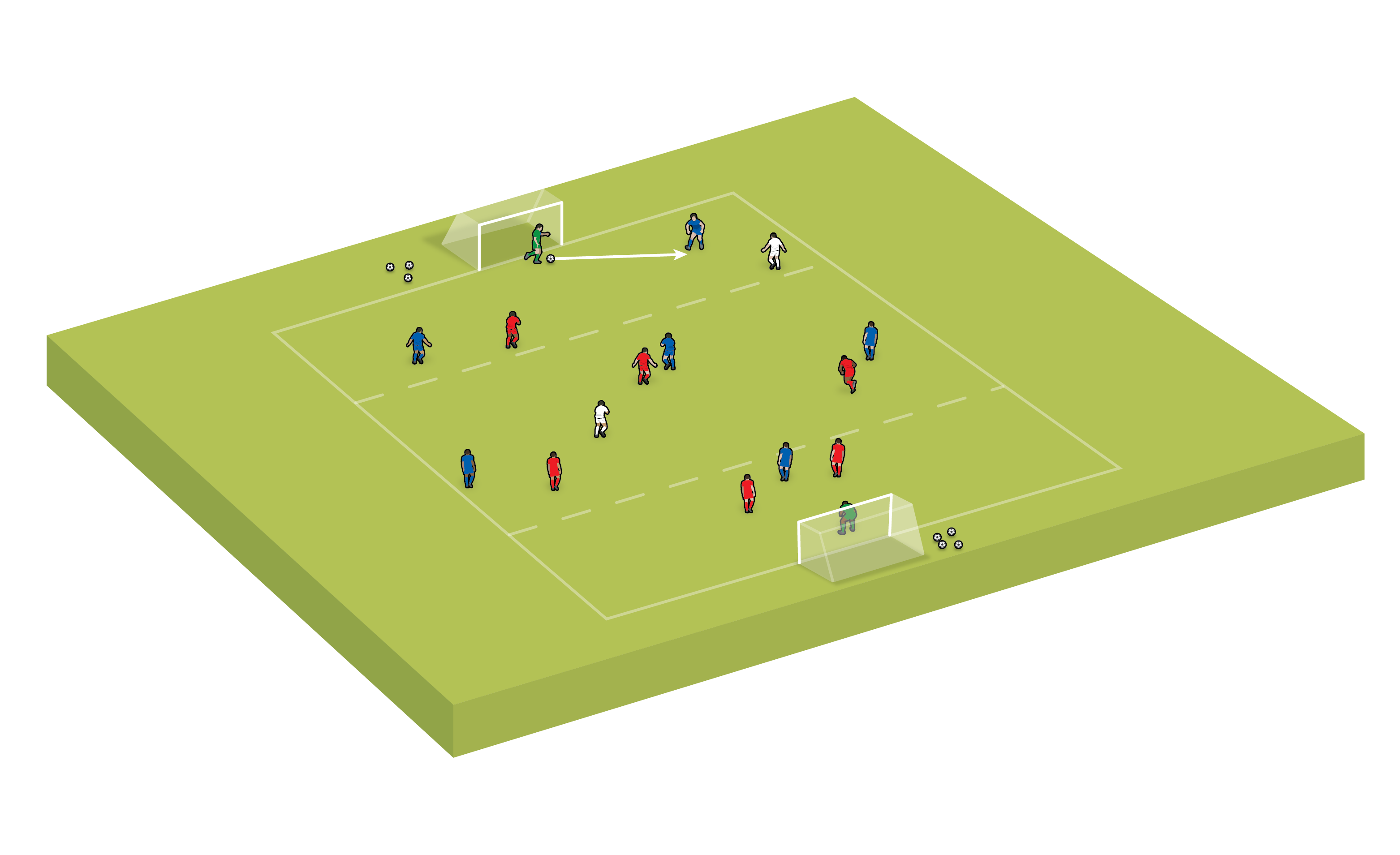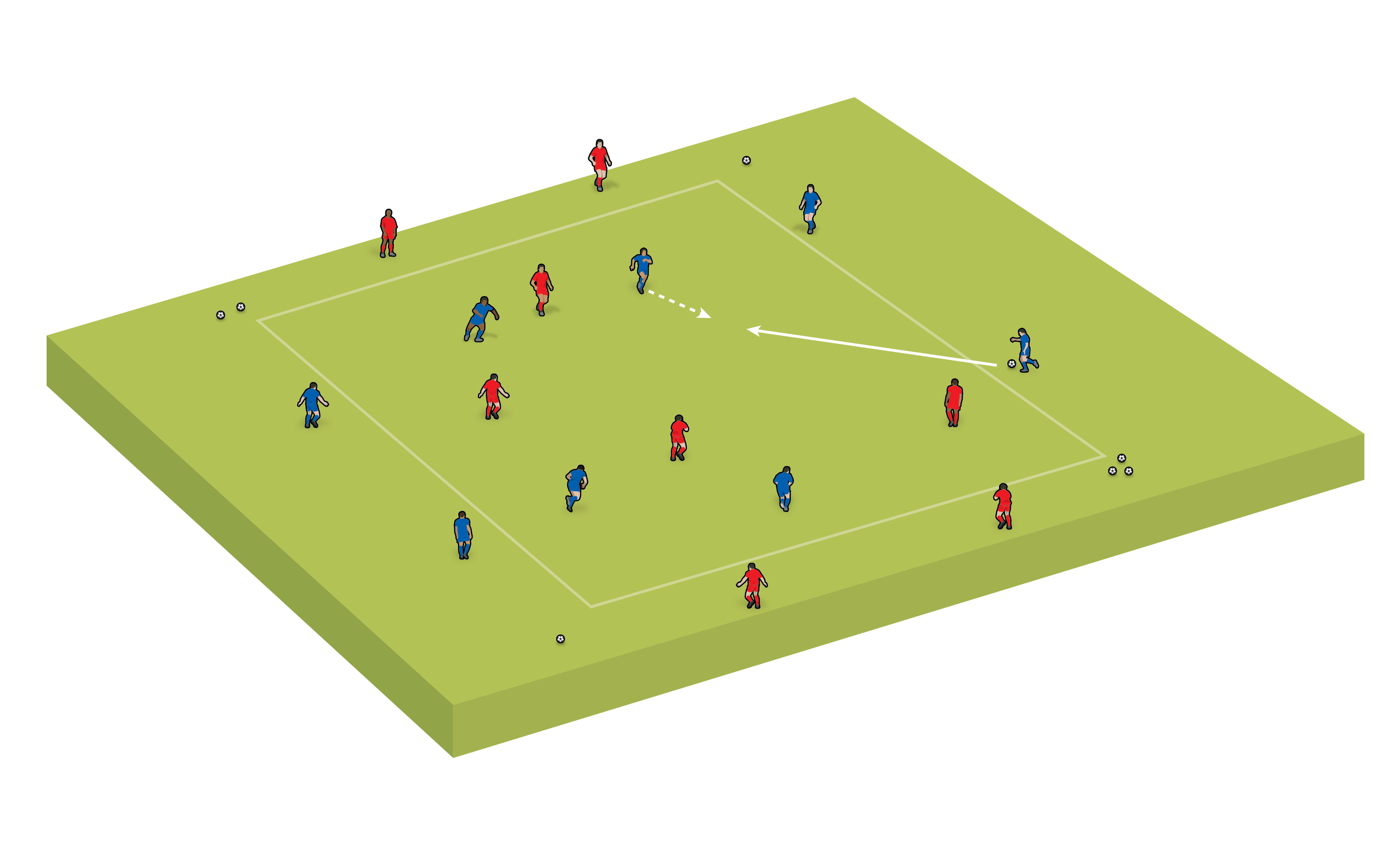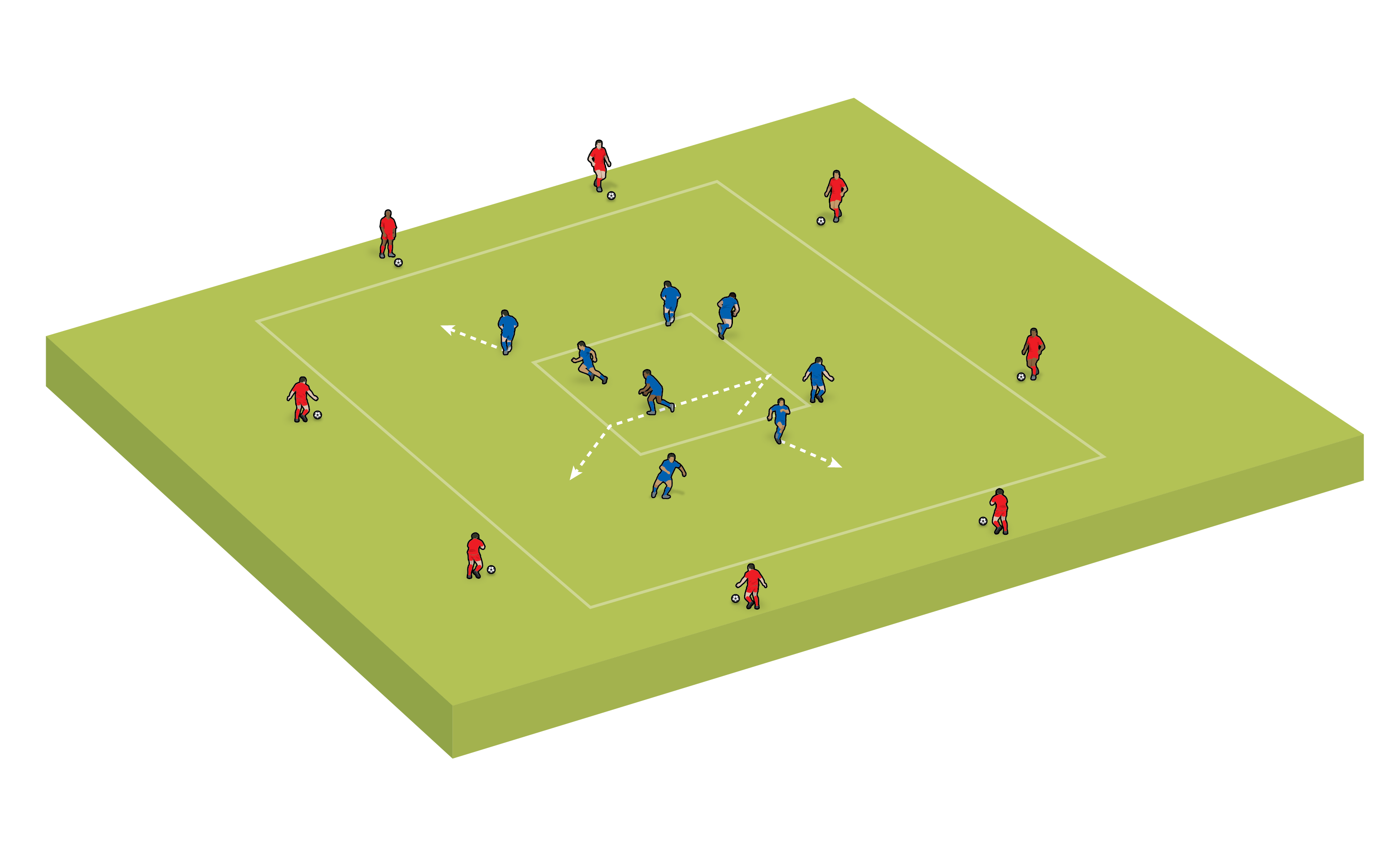7-a-side formation: 2-1-2-1
Why choose this 7v7 formation? Review the pros and cons, in possession and out of possession principles, and each position
Progresses from: 1-2-1 (4/5-a-side)
Progresses to: 3-1-2-1-1 (9-a-side)
PROS OF THIS FORMATION |
CONS OF THIS FORMATION |
|
|
|
|
|
|
|
7v7 2-1-2-1 - IN-POSSESSION SUMMARY
IN-POSSESSION PROS |
IN-POSSESSION CONS |
|
|
|
|
2-1-2-1 IN-POSSESSION - BY POSITION
Goalkeeper
This formation tests the goalkeeper’s ability on the ball and their awareness to quickly identify a team-mate they can pass to.
Because the formation is so narrow, it is easier for the opposition to make the central area compact and cut off passing lines.
However, this is counteracted by the additional unit – there are four in this formation, rather than the three found in most others. This makes it more difficult for opposition players to decide who they should mark and keeping track of their movements.
Therefore, when the goalkeeper is in possession, they will probably need to wait for some of their team-mates to move into better positions to receive the ball.
The goalkeeper must be confident and patient in possession, because there will be times when they need to stay on the ball while they wait for a team-mate to provide some support.
In addition, they will need to have good awareness and be decisive in their actions, as once a team-mate does move to receive the ball, the goalkeeper will need to identify this quickly and play the pass promptly.
Defenders
In this formation, defenders will develop a better understanding of where they need to be in order to effectively support their team-mate in possession.
As the goalkeeper may need to hold onto the ball for longer than they might like, they will probably be closed down by an opponent. That opponent will likely come from an area where they were impacting a defender’s ability to receive a pass.
This offers an opportunity for the defender. To make themselves an option to receive the ball, they will likely have to change their position, because the line the ball needs to travel to reach them may be blocked by the opponent moving towards the goalkeeper.
The defender, therefore, must quickly identify the fact that the goalkeeper needs them to adjust their position.
They will then need to think about their body position. Ideally, they should have an open body, so they can receive the ball on their back foot and play forward.
The challenge when doing this is that their initial movement will be to run towards their own goal.
Therefore, either once they have arrived, or as they are arriving, they need to remember to open their body.
This can be a difficult concept for younger players, whose main focus will be watching the ball and ensuring they secure it should it come to them.
Related Files
- Attacking midfielders must decide whether to release the ball or keep it themselves
- The forward works on their movement and supporting runs
- Central midfielder has a key role, acting as the link between the defence and attack
- Defenders must think about their body position when they show to receive the ball
- Goalkeeper must be confident in possession as they wait for team-mates to get into positions to receive
Central midfielder
This player has a key role when the team is in possession, acting as the link between the defensive players and the attack.
They will receive the ball from players positioned both behind and ahead of them. And, of course, they will also play passes to these same players.
The central midfielder will always be surrounded by team-mates and opponents, whether they have the ball or are looking to receive it.
A key requirement of the position is, therefore, to have good awareness of who, and what, is around them. This will help them and their team to retain possession.
To develop awareness, players should be encouraged to scan the field. As coaches, we often ask our players to check their shoulders, so they can see what is behind them. But this player needs to go beyond that – they must observe all areas of the field, especially those parts in and around where they are positioned.
Playing in this position will help players to develop an understanding of the importance of knowing what they are going to do with the ball before they receive it, allowing them to make earlier decisions and play quicker.
Attacking midfielders
This is possibly the most interesting position in this formation when the team has the ball.
If they can get in the correct position – not too high up the field, too close to their striker – the attacking midfielders can receive the ball in a good amount of space. They should then have a number of options in terms of what to do with the ball, all of which can put them or a team-mate in a situation where they are a real threat to the opposition’s goal.
If receiving in space close to their opponent’s goal, the player can be really positive and drive at goal. Doing this should force a defender to move towards them and close them down, providing more space for the striker to work in.
"The forward will often be providing support, rather than being in possession..."
Receiving the ball in space allows the player to travel with it at speed, which is difficult to defend against. Playing in this position gives players a good opportunity to develop their attacking ability in 1v1s.
This can also increase their levels of self-esteem and improve key physical performance elements, including co-ordination, balance and agility.
Decision-making is also tested in this position: players must decide whether to release the ball to a team-mate, likely one of the strikers, or keep it themselves and attempt to dribble past their opponent.
When they do look to pass it, they need to be able to do so while travelling at speed, developing their passing skills.
Forward
With two team-mates positioned close to them when the team are attacking, the forward in this formation will often be providing support, rather than being the player in possession.
This formation, therefore, provides the forward with an opportunity to work on their movement and supporting runs.
The key to these movements is, firstly, moving out of the space their team-mate wants to travel into.
A forward moving into a different area of the field to that of a team-mate on the ball will help to create space, making it easier for the player in possession to dribble into and potentially go past their opponent.
It will also make it more difficult for the opposition defenders to deal with the players on the ball and the potential recipient of a pass.
Players must also focus on their body position as they move away from their team-mate. Younger players are likely to run away from the ball and head towards their opponent’s goal, unaware of the intentions of their team-mate.
When a forward is making a forward movement, they need to be encouraged to adjust their body shape so that it is open, allowing them to still see what their team-mate is looking to do.
7V7 2-1-2-1 - OUT-OF-POSSESSION SUMMARY
OUT-OF-POSSESSION PROS |
OUT-OF-POSSESSION CONS |
|
|
|
|
|
|
2-1-2-1 OUT-OF-POSSESSION - BY POSITION
Goalkeeper
With so many players situated in a central area, the opposition will find it very difficult to penetrate through the middle and are therefore more likely to go around.
This does not necessarily mean using a wide area, though. As the formation is so narrow, most of the players will be positioned within the width of the goalposts. Therefore, going around, by dribbling or passing, can be done in the central channel.
This means the player in possession will be in a position to have a shot, albeit from an angle rather than directly in front of goal. These shots are likely to be aimed at the far side of the goal, across the goalkeeper.
Dealing with these types of shots will allow the goalkeeper to work on getting their angles correct, so that they do not get beaten at their front post, while also ensuring they have the rest of the goal covered.
These shots will also enable the keeper to develop the techniques needed to save them, including a full-stretch dive and the ability to push the ball away from danger.
Defenders
Defenders will have lots of protection when the team is out of possession.
It is therefore a good set-up to use if the players in these defensive positions are not confident when defending. They will have a partner next to them and a team-mate positioned just in front of them.
Because of this extra protection, it is likely they will often find themselves being the ’second’ defender. There will, therefore, be an emphasis on getting their positioning right when providing support to the team-mate who is applying the pressure; the first defender, likely to be the central midfielder.
The opposition player will look to either go past the player pressing them or release the ball to a team-mate in space. Because this formation has so many players situated centrally, the opponents in space will be those in wide areas.
The second defender therefore needs to be able to position themselves so that they can either engage the player on the ball should they need to, or get across to a player in a wide area, should the ball be played to them.
How far away the second defender is from the first defender, in terms of both distance and angle, is crucial to getting this right.
- Attacking midfielders must recover and help defend when the team loses the ball
- With team-mates close to them, the forward can do more than just apply pressure – decision-making will be vital
- The central midfielder should keep their position between the defence and the attacking midfielders and not drop into the back line
- Defenders will have lots of protection when the team is out of possession
- With the central area congested, goalkeepers may have to deal with more angled shots
Central midfielder
In this formation, the central midfielder can develop their understanding of where they should position themselves when the team does not have the ball.
With a number of players positioned just ahead of them, it is likely that they may start to drop into the back line, turning the defensive unit into a back three.
The central midfield player should instead be encouraged to keep their position between the defence and the attacking midfielders, because this is where they are best placed to force the opposition away from goal.
The key to being in the correct position to help the team defend effectively is the ability to read the game and predict what is going to happen next.
At the younger age groups, experience of playing the game is more limited - therefore, the ability to recognise what is likely to happen will also be restricted.
Simple challenges can be given to the central midfielder to prompt their development around their reading of the game, such as: "Can you try to guess where the ball will go next?".
This type of question will provide the player with a bit of a focus on this particular element of their position.
Attacking midfielders
The challenge the attacking midfielders face in this formation is having to recover and help defend when their team loses the ball.
Because they are positioned high up the pitch, they will see themselves as attacking players and may not think they are needed when the team has to defend. We need to consider how we can change their mindset, so that their first instinct when the team loses possession is to help win it back.
Simple challenges can be given, such as asking both players: "When the ball goes past you, which player can get goal-side of the ball the quickest?".
"The key to being in the correct position to defend is the ability to read the game..."
On the flip side, having these two players and the forward in advanced positions means the team can put a lot of pressure on the opposition’s back line when they are in possession, providing a good opportunity to win the ball high up the pitch.
The danger in this instance is that the defenders break the press by passing it to a team-mate in an advanced position, likely a player in a wide area.
If this pass is successful, the opposition will be in a good position to attack, having by-passed half of our team’s players.
It is therefore important for the two attacking midfielders to work on their understanding of when they should put pressure on the ball and when to demonstrate patience.
If they are going to press the ball, they need to be confident that they can win it before the opponent has a chance to pass.
Forwards
Having two attacking midfielders just behind them allows the forward to play more of a defensive role, when required.
With team-mates close to them, the forward can now do more than just apply pressure, something they are often limited to in formations where they are more isolated.
If the two attacking midfielders close down the opposition defenders, for example, the forward can position themselves in an area where they can possibly intercept the ball or support a team-mate in pressing.
A lot of learning that takes place for the forward out of possession is around decision-making. Deciding where to go and whether to press the ball or be patient will have a significant impact on how effective the team is when defending.
Newsletter Sign Up
Coaches Testimonials

Gerald Kearney, Downtown Las Vegas Soccer Club

Paul Butler, Florida, USA

Rick Shields, Springboro, USA

Tony Green, Pierrefonds Titans, Quebec, Canada
Subscribe Today
Discover the simple way to become a more effective, more successful soccer coach
In a recent survey 89% of subscribers said Soccer Coach Weekly makes them more confident, 91% said Soccer Coach Weekly makes them a more effective coach and 93% said Soccer Coach Weekly makes them more inspired.
*includes 3 coaching manuals
Get Weekly Inspiration
All the latest techniques and approaches
Soccer Coach Weekly offers proven and easy to use soccer drills, coaching sessions, practice plans, small-sided games, warm-ups, training tips and advice.
We've been at the cutting edge of soccer coaching since we launched in 2007, creating resources for the grassroots youth coach, following best practice from around the world and insights from the professional game.
